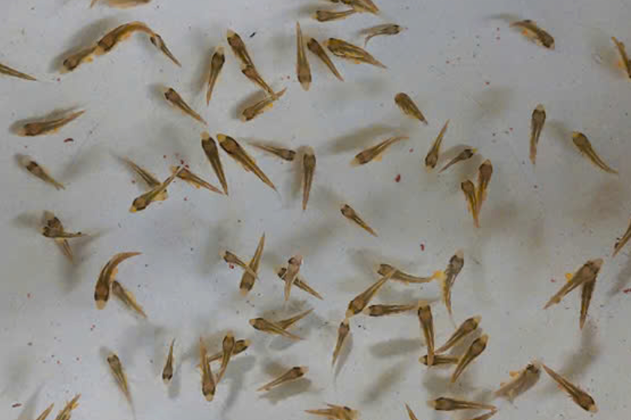Recently, the Research Institute for Aquaculture No. 1 (under the Ministry of Agriculture and Environment) in Vietnam successfully achieved artificial breeding of amberjack fish (Seriola spp).
This accomplishment is particularly notable as Japan and China—the world’s largest consumers of amberjack—have made efforts but have yet to breed the species successfully.
According to Associate Professor Dr. Dang Thi Lua, Director of the Research Institute for Aquaculture No. 1, the institute had developed a broodstock of amberjack fish sourced from the wild, with an average weight of 10 kg per fish and an average age of 5–6 years. From this broodstock, the institute conducted artificial spawning trials for the first time in April 2025, and the results were successful.
 Photo: 20-day-old amberjack. Photo: Dang Lua.
Photo: 20-day-old amberjack. Photo: Dang Lua.In this first artificial spawning attempt, the institute obtained about 3 million eggs, with a fertilization rate of over 90%. Initial results showed that hatching in outdoor ponds occurred 6–8 hours earlier than in tank incubation.
Preliminary findings from the amberjack breeding study indicated that the fish began accepting and utilizing formulated feed instead of natural feed on the 18th day of the nursery stage. This marks a breakthrough, as the transition to industrial feed is considered a crucial technical stage in fish farming. The amberjack fry is now 23 days old, making Vietnam the first country in the world to have successfully bred amberjack.
Amberjack is classified as a premium marine aquaculture species due to its rapid growth rate, capable of reaching 3 kg in 18 months of farming. The species is widely distributed in warm sea areas worldwide and is suitable for offshore cage farming, which helps reduce pressure on nearshore aquaculture.
Amberjack is commonly farmed in countries like Chile and Mexico. In Japan, it is a key marine aquaculture species, accounting for more than 50% of total marine aquaculture production. Highly favored in Japan, amberjack is widely used in sashimi and sushi, with a market price of about VND 1 million per kilogram (approximately USD 40).
This successful research opens up significant potential for the industrial-scale development of marine aquaculture in Vietnam, reducing dependence on increasingly depleted wild seed sources.